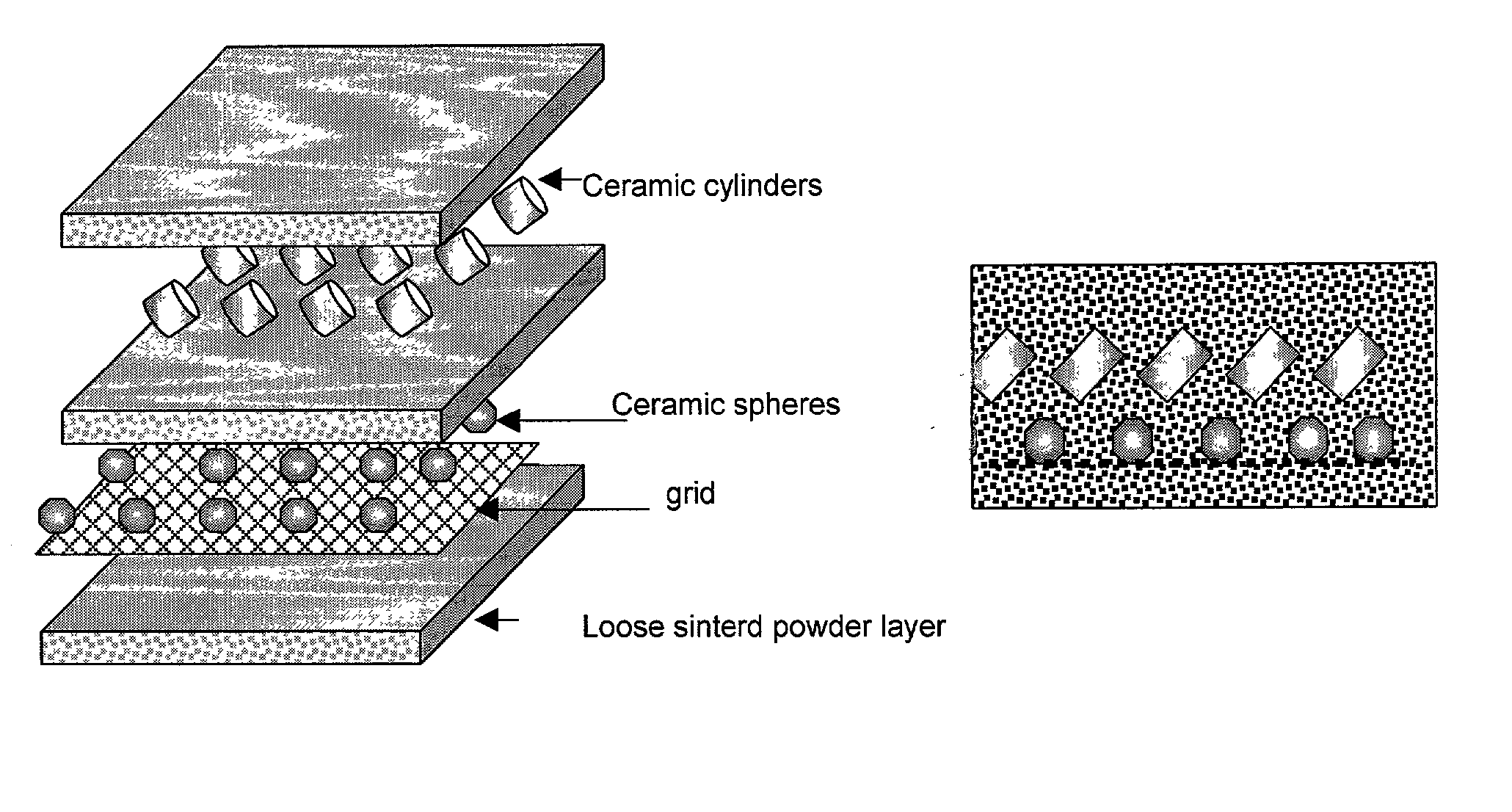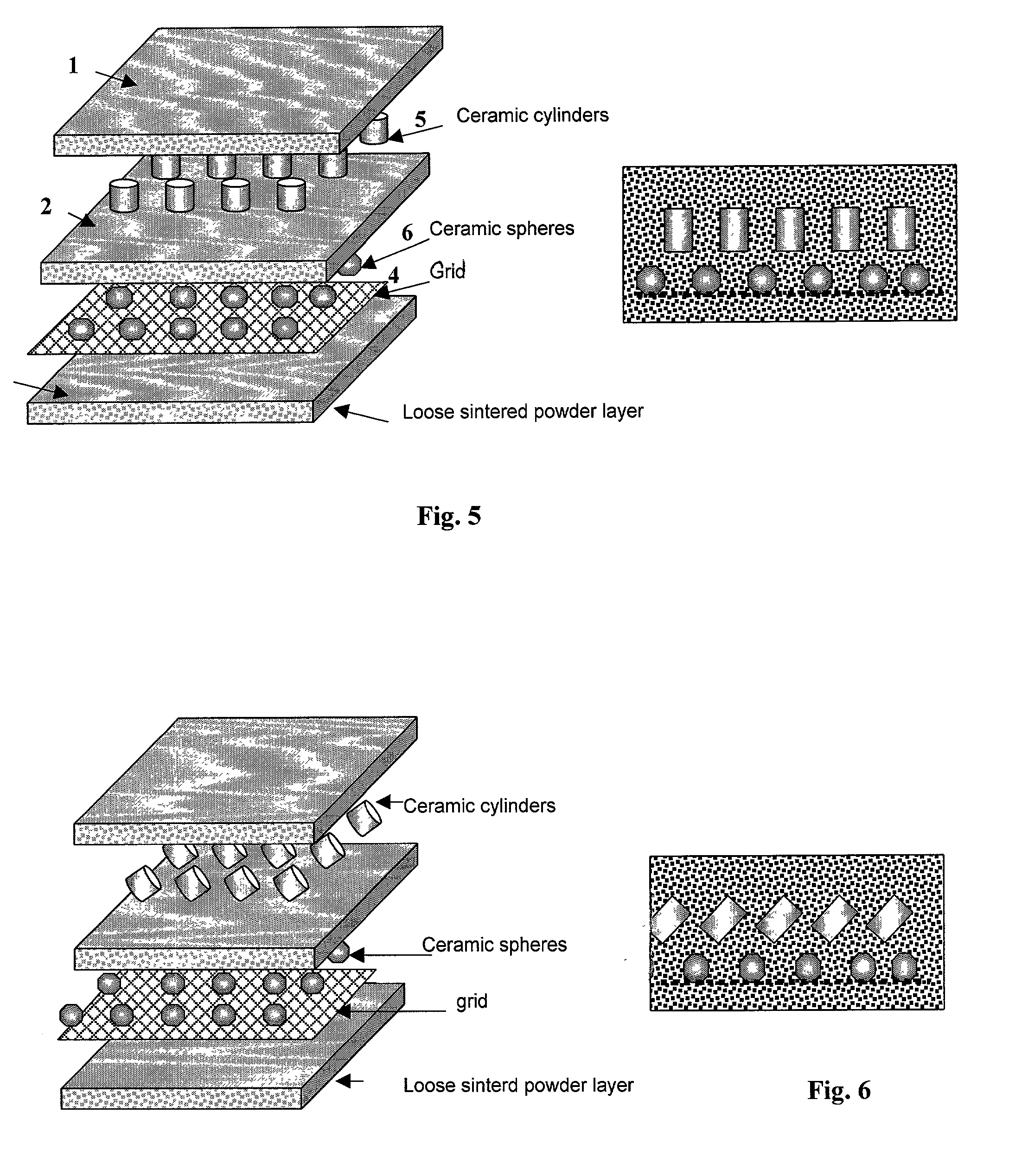Bulletproof lightweight metal matrix macrocomposites with controlled structure and manufacture the same
a macrocomposite and lightweight technology, applied in the direction of manufacturing tools, transportation and packaging, solventing apparatus, etc., can solve the problems of insufficient protection in many situations, materials and structures are usually too complex and heavy to be suitable for airplanes and vehicles, and the solution to this problem is not reliable and expensive. , to achieve the effect of stopping crack propagation
- Summary
- Abstract
- Description
- Claims
- Application Information
AI Technical Summary
Benefits of technology
Problems solved by technology
Method used
Image
Examples
example 1
[0042] The C.P. titanium powder having a particle size of--100 mesh was placed in a flat graphite mold to form a layer measuring 6".times.12".times.0.25". Alumina cylinders (0.5" diameter, 0.25" height) were placed on loose titanium powder in the order showed in FIG. 1a using a titanium grid. The grid and alumina inserts were covered with the additional titanium powder to fill the spaces between cylinders and to form first composite layer. Next alumina inserts were positioned over the gaps between inserts of the first layer, and covered with titanium powder again to form the second composite layer. Then, both layers were loose sintered together at 1100.degree. C. to obtain a skeletal structure having a density of .about.35%. The infiltrating alloy having the composition of Mg-10 wt. % Al was placed on the top surface and heated in vacuum to 700.degree. C. to infiltrate said titanium / ceramic skeletal structure.
[0043] The infiltrated plate was treated by hot isostatic pressing at 550....
example 2
[0046] The same skeletal structure as in Example 1 was manufactured using alumina spheres of 0.25" dia. for the first layer and the same alumina cylinders for the second layer. The titanium grid was not removed from the first layer and was integrated into the macrocomposite structure as showed in FIGS. 5 and 6. The obtained preform was infiltrated with Mg-50 wt. % Al alloy melt at 700.degree. C. The infiltrated composite plate was HIPed and annealed for 4 h at 400.degree. C. The rigidity of the composite material was increased by the presence of the metal grid in it, therefore, the specimen was not completely broken in the impact testing. The value of impact strength showed in the Table is related to a crack occurrence in the specimen.
example 3
[0047] The same skeletal structure as in Example 1 was manufactured using the same procedure, but the infiltrating Mg-10 wt. % Al alloy was placed on top surface of the preform in a quantity insufficient for full infiltration of the porous preform. This results in local thorough porosity of the macrocomposite plate. The impact strength of the specimen was decreased, but the resulting material having local areas permeable for air, may be useful in the design of products such as bulletproof vests.
PUM
| Property | Measurement | Unit |
|---|---|---|
| particle size | aaaaa | aaaaa |
| porosity | aaaaa | aaaaa |
| thick | aaaaa | aaaaa |
Abstract
Description
Claims
Application Information
 Login to View More
Login to View More - R&D
- Intellectual Property
- Life Sciences
- Materials
- Tech Scout
- Unparalleled Data Quality
- Higher Quality Content
- 60% Fewer Hallucinations
Browse by: Latest US Patents, China's latest patents, Technical Efficacy Thesaurus, Application Domain, Technology Topic, Popular Technical Reports.
© 2025 PatSnap. All rights reserved.Legal|Privacy policy|Modern Slavery Act Transparency Statement|Sitemap|About US| Contact US: help@patsnap.com



